Why Do Hawks Screech? Decoding Hawk Vocalizations
Hawks have distinctive ways of vocalizing their needs and delivering their messages to fellow hawks. Similarly, researchers have been working relentlessly to discover the secret meanings behind hawk communication.
Hawks generally screech to protect their territory. When they face their competitors, they tend to scream to claim their territory as their own. Screeching is also a part of their hunting technique. You will be amazed to know even weather can influence their screeching habit.
Understanding hawk screeches gives us the freedom to explore their way of communication, territorial behavior, and courtship rituals. Let’s explore the vocal skills of these magnificent birds and the importance of their vocalizations in their ecological interactions.
What Triggers Hawks to Screech?
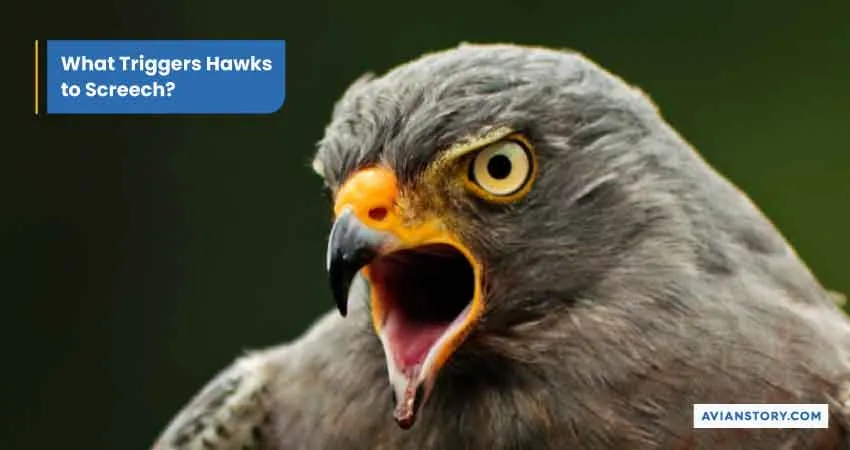
Hawks fly in groups, and they communicate with each other by screeching during this time. Screeching helps hawks during their migration time to navigate their ways of communicating with other hawks.
Here we have gathered some fascinating hawks facts about the main motivations behind Hawk’s screech;
Territorial Warnings and Threats
Hawks have a reputation for being highly territorial birds. If they can sense any intruder trying to enter their territory, they use screeching as their weapon. It is a warning sign for another hawk or potential threat to back down. They screech to establish their dominion during territorial disputes.
The Art of Avian Seduction
Though hawks are known for their aggression, they can be romantic too during mating season. Hawks love to screech while keeping their hopes high to attract a mating partner.
A male hawk screeches and lets other potential suitors know that this is his territory for the mating season. He fights his way out to find his mate, and the primary communication happens through screeching.
Influence of Weather Conditions
Weather changes can affect or change the way hawks normally screech. For instance, when hawks fly in windy and stormy weather, they focus more on their flying pattern. During this turbulent weather, they may yell differently or not shout at all. They will also look for shelter instead of vocalizing.
Nest Building
During the nest building process, hawks gather materials from various places. Hawks frequently swap nesting materials (such as sticks, twigs, and leaves) with one another as they work on the nest. Hawks interact with one another through vocalizations when constructing nests. These yells, screams, and whistle shows that they are prepared to work on the nest and are eager to help with the breeding process.
Juvenile Hawk Communication Training
Like any good parent, hawks shriek to discipline their young. Juvenile hawks squeal instead of screeching. Females and nestlings use calling to communicate with their male partners throughout the nesting season.
Unlike adult hawks, juvenile hawks have a much more subdued call. You will be surprised to know just like humans; hawks also screech to scold their juveniles.
Young hawks may communicate with other hawks or their carers by making contact calls like adult hawks. Hawks use these cries to keep in touch with a group or family.
Disturbed by Human Activities
We often forget that we share this planet with other creatures, including hawks. The human invasion has damaged the natural habitats of hawks in many parts of the world. The frequent human interruption has affected Hawks’ nesting site and vocalization pattern.
Due to human invasion, hawks feel vulnerable and out of distress, they screech. They screech to protect their home and set alarm for other hawks during threatening human activity near their nest. Another interesting hawk fact is captive hawks have slightly different vocal patterns to wild hawks due to their proximity to humans.
Strategic Use of Screeching in Hunting
Hawk’s level of intelligence can be understood by how they scare their prey by screeching to find their location. The loud sound startles the prey, which are mostly small animals. They end up coming out of their hiding places, and Hawk grabs their meal for the day.
During hunting, hawks communicate with each other through screeching. They use their vocal power to coordinate to improve their hunting collaboration.
They also do this when they fly in a group. A group of hawks is called a kettle. While flying in a kettle they notify their team members about prey’s hiding places by yelling.
What Makes the Screeching Sound of Hawks Unique?
Hawks can emit loud and regulated screeches thanks to their unique vocal structure, which includes a well-developed syrinx.
The essential elements of a hawk’s screech include several factors contributing to their distinctive vocalizations. Hawk screeches are a high-pitched, piercing sound that may be heard from a long way. Their screeches generally range between 2,000 and 10,000 Hertz, enabling efficient communication and intimidation.
A hawk’s shriek can last between a few seconds and several minutes, depending on the situation and intent. These vocalizations are used for various purposes, including courting, hunting, territorial defense, and interspecies communication.
The Unique Aspects of Hawk Screeches Compared to Other Raptors and Non-predatory Birds
The distinctive qualities of hawk screeches set them apart from the vocalizations of other raptors and non-predatory birds. Knowing these unique traits offers helpful insights into the exciting realm of hawk communication.
Let’s have a look at the differences between hawks’ screeches in comparison to other raptors and non-predatory birds.
| Aspect | Hawks | Raqptors/ Non-Predatory Birds |
| Vocal Anatomy | Have an advanced syrinx that enables complicated vocalizations | Lack a syrinx, which limits their ability to communicate |
| Tone And Pitch | Emit harsh, high-pitched sounds that differ between species. | May generate a variety of calls, although not always high-pitched. |
| Intensity | Create ferocious, furious screeches for communication and hunting. | Lack of the ferocity of sounds made by predatory birds |
| Hunting Nature | Use screeching to frighten prey and locate them, | Never rely solely on vocalizations when hunting. |
| Communication | Use screeches for courting displays and territorial threats. | Use a variety of calls, songs, and melodies to communicate |
| Species Variation | Demonstrate differences in screeching pitch, tone, and pattern between several species. | Show a broad range of vocalizations unique to each species. |
What Do Different Hawk Screeches Sound Like?
Each species of hawk has its vocal repertory. There are several types of Hawks available in the wild. From Red-tailed Hawk to Cooper’s Hawk, all demonstrate their uniqueness through their screeching. Here we will explore what different hawk screeches sound like and what makes them special:
Broad-winged Hawk
Broad-winged Hawk is a dark-brown common American hawk with brown and white streaks on its underside.
- It emits a loud, high-pitched shriek.
- Many people describe the shriek as having a whistling “kee-ee” or “wee-oo” sound.
- Usually, the call is re-issued several times in fast succession.
- Its pitch rises and falls in a particular manner, giving it a characteristic “whistle-like” impression.
Red-tailed Hawk
Large Red-tailed Hawks have characteristic Buteo dimensions, with vast, rounded wings and a short, broad tail.
- The cry of the Red-tailed Hawk is frequently called a piercing, shrill “keeeeeeer” or “keeeeee-yar” sound.
- The shriek can be prolonged, but the pitch stays constant.
- Robust and capable of traveling great distances, the call.
Cooper’s Hawk
A medium-sized woodland bird, the Cooper’s Hawk inhabits various environments.
- It makes a loud, repeated call.
- The scream is sometimes characterized as a quick succession of high-pitched “kik-kik-kik” or “kek-kek-kek” noises.
- The calls are often made quickly, one after the other, giving them a characteristic beat.
- Depending on the situation and the hawk’s actions, the shriek might change in volume and pitch.
Why Do Hawks Screech Most at Dawn And Dusk?
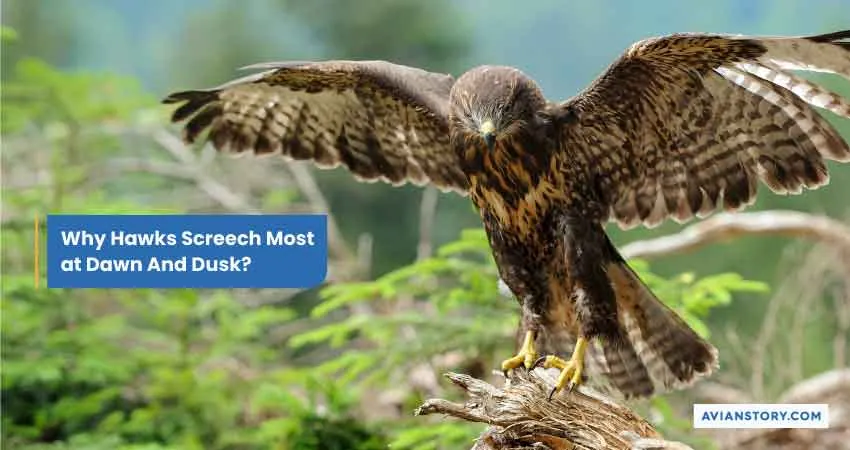
Hawks prefer hunting during dawn and dusk. Moreover, hawks screech more at dawn and dusk because their prey is active in these transitional phases.
Lighting conditions during this time provide an ideal opportunity for hawks to spot and catch their targets. Additionally, they use screeching to establish their boundaries during dawn and dusk.
But do Hawks hunt at night? By the way, hawks avoid hunting at night.
Can Hawk Screeching Signal Physical or Emotional Distress?
Physical discomfort or illnesses can make a hawk screech more than usual. If they are injured, they may express it by making sounds. They can seek help from another hawk by attracting their attention through their distress call.
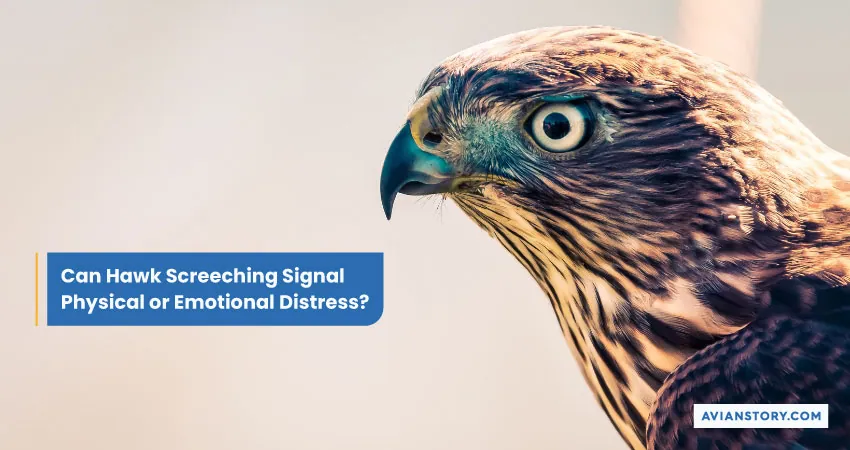
Emotional distress is another sign of hawks screeching. Fights with other hawks or habitat disruption can result in intense screeching by hawks. They express their fear and anxiety by screaming.
Links Between Fear, Anxiety, And The Intensity Of Hawk Screeches
“Alarm Call” is a vocal way of letting other birds or animals know about impending danger. Hawks also use this technique through their vocalization when a potential threat is nearby.
When they become anxious and feel threatened, their screech becomes louder and more intense. Specifically, their tone becomes more aggressive to scare their enemy.
Hawks aren’t dangerous to humans, but human activities can become potentially dangerous for them. Especially during their breeding season, human interference can disrupt their life and create fear in them.
If a hawk is experiencing fear or anxiety, it also affects its screeching pattern. They tend to vocalize more while flying. Thus, they dive more rapidly and screech out of fear.
How Do Researchers Decode and Utilize the Screech of Hawks?
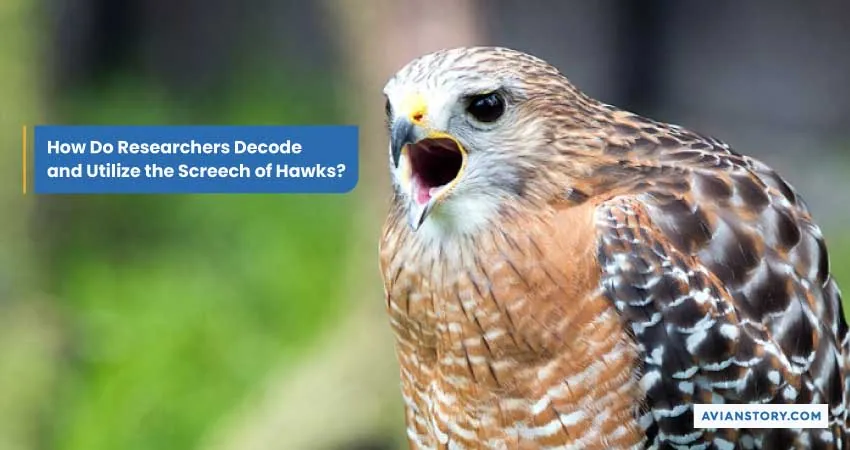
Decoding hawks screeching gave researchers a closer view of the hawk world to discover more facts. Field analysis is a process that takes researchers into the wild to observe hawks from an up-close point of view.
Technology like the acoustic analysis process has opened doors to capture hawk vocalization to analyze them for scientific research.
Field Observation
Researchers spend years trying to grasp a better understanding of hawks’ behavioral and vocal patterns. They stay on the ground to document all the screeching events during the important phases of the hawk’s life cycle.
According to a study, mountain hawks produced multiple types of vocal tones in different circumstances, from juvenile begging calls to alarm calls. This study also showed flying calls were the most common they heard during their research process.
Acoustic Analysis
Due to the availability of advanced technology, researchers are using audio recorders to track and analyze different types of hawk screeches. These recordings give researchers in-depth knowledge about the pitch, duration, and frequency of hawk screech.
A study showed parent-offspring were using the same kind of first note they use during flying calls. But the call duration was longer than the flying call.
During another field study, the researcher recorded near a hawk nesting site. After coming out from the jungle, when they listened to the acoustic recording, they could understand the vocal tones of different chicks.
How Understanding Hawk Screeching Can Contribute To Conservation Efforts And Public Awareness?
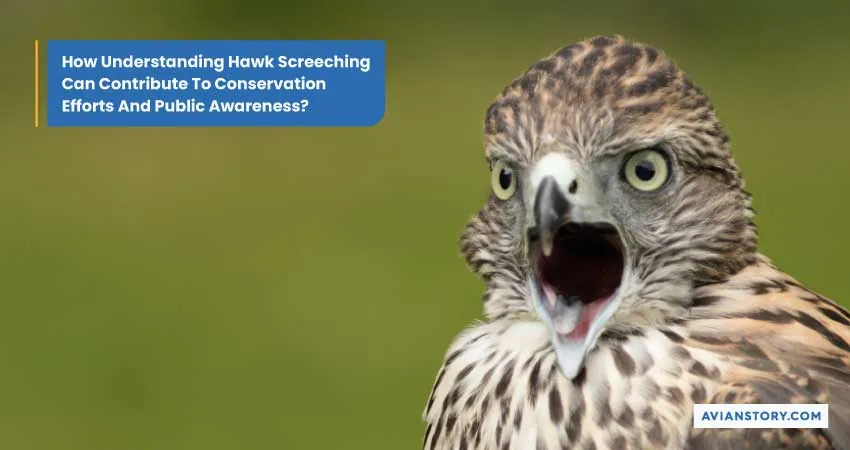
Federal and state laws protect hawks and owls, but the public needs to be more aware to protect their habitats. According to a study, around 52% of the raptor species are facing the threat of decline.
But the good news is the number of the largest hawk species is increasing because of conservation work.
Unless people understand the reasons behind hawk screech, they won’t be able to ensure they are safe in the wild. Due to massive urbanization, many wild species of raptors are in danger.
Research and understanding their vocal pattern are crucial to saving hawks from living miserable lives. Here’s how it helps;
- Helps to identify the accurate number of species.
- Differentiates their vocal pattern.
- Provides researchers with the opportunity to continue research to improve their quality of life.
- Raises public awareness and helps conservationists to protect hawks.
- Initiates protection measures for Hawks.
Bottom Line
Hawks are magnificent birds that have been flying in the wild for years and won our hearts through their captivating persona. We get to hear their screech when they fly above us in the open sky and wonder why do hawks screech. Hawks screech serve various purposes in their life cycle.
They convey several types of messages among their species and threaten others as well. Screeching is also a part of their defense mechanism and a tool to attract a mate in the mating season. They scream out of fear or to display their dominant presence.
Overall, by having a better understanding of hawks’ behavior, people can address the importance of conservation and improve their ecological needs.
